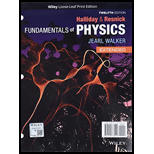
Concept explainers
SSM Identical 50 µC charges are fixed or an x axis at x = ±3.0 m. A particle of charge q = −15 µC is then released from rest at a point on the positive part of the y axis. Due to the symmetry of the situation, the particle moves along the y axis and has kinetic energy 1.2 J as it passes through the point x = 0, y = 4.0 m. (a) What is the kinetic energy of the particle as it passes through the origin? (b) At what negative value of y will the particle momentarily stop?
Trending nowThis is a popular solution!

Chapter 24 Solutions
FUNDAMENTALS OF PHYSICS - EXTENDED
Additional Science Textbook Solutions
Cosmic Perspective Fundamentals
Chemistry: An Introduction to General, Organic, and Biological Chemistry (13th Edition)
Fundamentals Of Thermodynamics
Chemistry
Chemistry: Structure and Properties (2nd Edition)
Human Anatomy & Physiology (Marieb, Human Anatomy & Physiology) Standalone Book
- Q9: When a wedding ring is thrown horizontally out of a fifth-floor window 15 m off the ground, it lands 7.5 m out from the base of the building. Calculate the throwing speed; (a) (b) the impact velocity; (c) how long the marriage will last. Q10: A girl on a sled with a combined mass of 50.0- kg slides down a frictionless hill from rest. When she gets to the bottom of the hill, she is traveling at 3.00 m/s. How high is the hill?" m = 50.0 kg HILL v, 3.00 m/s ■ 0 (ground)arrow_forwardThis is data I collected from a Centripetal Acceleration and Force lab. Please help with interpreting the data, thanks!arrow_forwardAnswer thisarrow_forward
- A coin is located 20.0 cm to the left of a converging lens. (f=13.0cm). A second, identical lens is placed to the right of the first lens, such that the image formed by the combination. has the same size and orientation as the original coin. Find the separation between the lenses.arrow_forwardA converging lens (f₁ = 10.9cm) is located 33.0 cm to the left of a diverging lens (f2=-5.64 cm). A postage stamp is placed 35.4 cm to the left of the converging lens. Find the overall magnificationarrow_forwardA farsighted man uses contact lenses with a refractive power of 2.00 diopters. Wearing the contacts, he is able to yead books held no closer than 25.0 cm from would like a his eyes. He prescription for eyeglasses to serve the same purpose. What is the correct prescription for the eyeglasses if the distance from the eyeglasses to his eyes is 200 cm 2.00 dioptersarrow_forward
- from a concave lens. The An object 5.3cm tall is 25.0 cm from resulting image is two-fifths is two-fifths as large the focal length of the lens? as the object. What is as cmarrow_forwardThe drawing shows a rectangular block of glass (n=1.56) surrounded by liquid carbon disulfide (n=1.64). A ray of light is incident on the glass at point A with a O₁ = 47.0° angle of incidence. At what angle of refraction does the ray leave the glass at point B? A Barrow_forwardThere is a magic item in Dungeons & Dragons called The Baton of Many Sizes, which is a staff that can magically change lengths between 0.305 m (1 foot) long and 15.2 m (50 feet) long, though it always has a mass of 3.18 kg. Assume the moment of inertia of the staff is 112mL2112mL2 where L is the total length. The angular acceleration is 4.9075 rad/s^2, the angular velocity is 17.57 rad/s. The staff then shrinks to a length of 1.12 m while no longer applying any torque. What is the staff’s new angular velocity?arrow_forward
- Finding my misplace science book what are the steps to in the given flowchart observe and question from a hypothesis test the hypothesis analyse and then the plate form a new hypothesis is the new hypot this is form a conclusionarrow_forwardSamus Aran from the Metroid series of video games has the ability to roll into a ball to get into smaller areas. Samus rolls down a path which drops down 22.0 m. If she was at rest when she started at the top, what is her linear velocity at the bottom of the path? Treat her as a solid sphere with a moment of inertia of 2/5 mr^2 .arrow_forwardMoon Knight, from both comics and the show of the same name, has crescent shaped daggers he throws at enemies. To throw a crescent dagger he applies a force of 0.918 N at an angle of 75.0° relative to the dagger’s center of mass at a point 0.0690 m away from the dagger’s center of mass. If the crescent dagger has a moment of inertia of 2.57⋅10^−5 kg⋅m^2 , what is the angular acceleration of a crescent dagger as it is thrown?arrow_forward
 Physics for Scientists and Engineers: Foundations...PhysicsISBN:9781133939146Author:Katz, Debora M.Publisher:Cengage Learning
Physics for Scientists and Engineers: Foundations...PhysicsISBN:9781133939146Author:Katz, Debora M.Publisher:Cengage Learning Principles of Physics: A Calculus-Based TextPhysicsISBN:9781133104261Author:Raymond A. Serway, John W. JewettPublisher:Cengage Learning
Principles of Physics: A Calculus-Based TextPhysicsISBN:9781133104261Author:Raymond A. Serway, John W. JewettPublisher:Cengage Learning Physics for Scientists and Engineers, Technology ...PhysicsISBN:9781305116399Author:Raymond A. Serway, John W. JewettPublisher:Cengage Learning
Physics for Scientists and Engineers, Technology ...PhysicsISBN:9781305116399Author:Raymond A. Serway, John W. JewettPublisher:Cengage Learning College PhysicsPhysicsISBN:9781285737027Author:Raymond A. Serway, Chris VuillePublisher:Cengage Learning
College PhysicsPhysicsISBN:9781285737027Author:Raymond A. Serway, Chris VuillePublisher:Cengage Learning College PhysicsPhysicsISBN:9781305952300Author:Raymond A. Serway, Chris VuillePublisher:Cengage Learning
College PhysicsPhysicsISBN:9781305952300Author:Raymond A. Serway, Chris VuillePublisher:Cengage Learning





